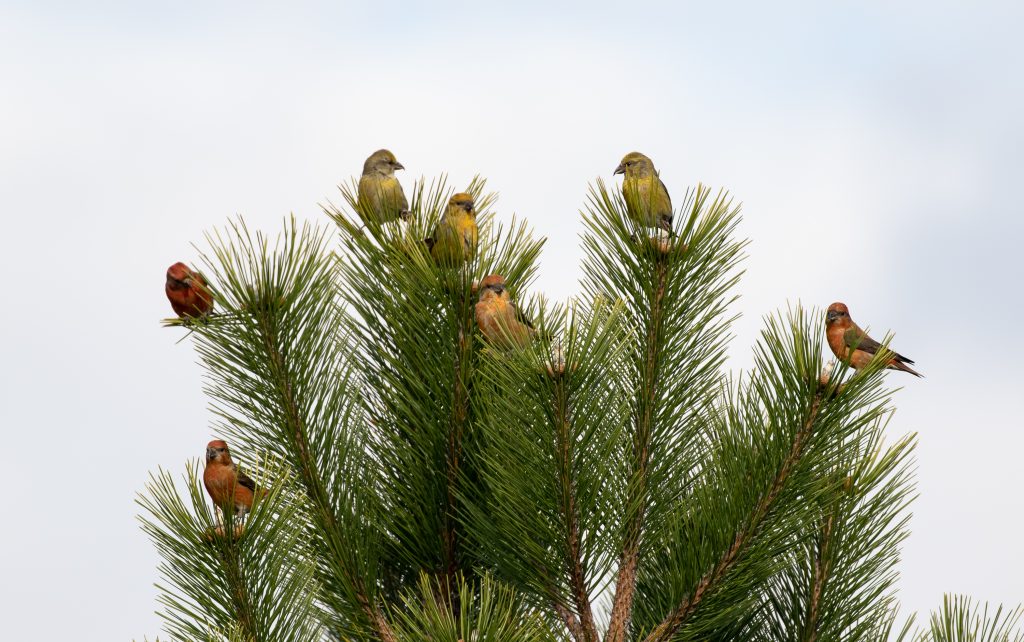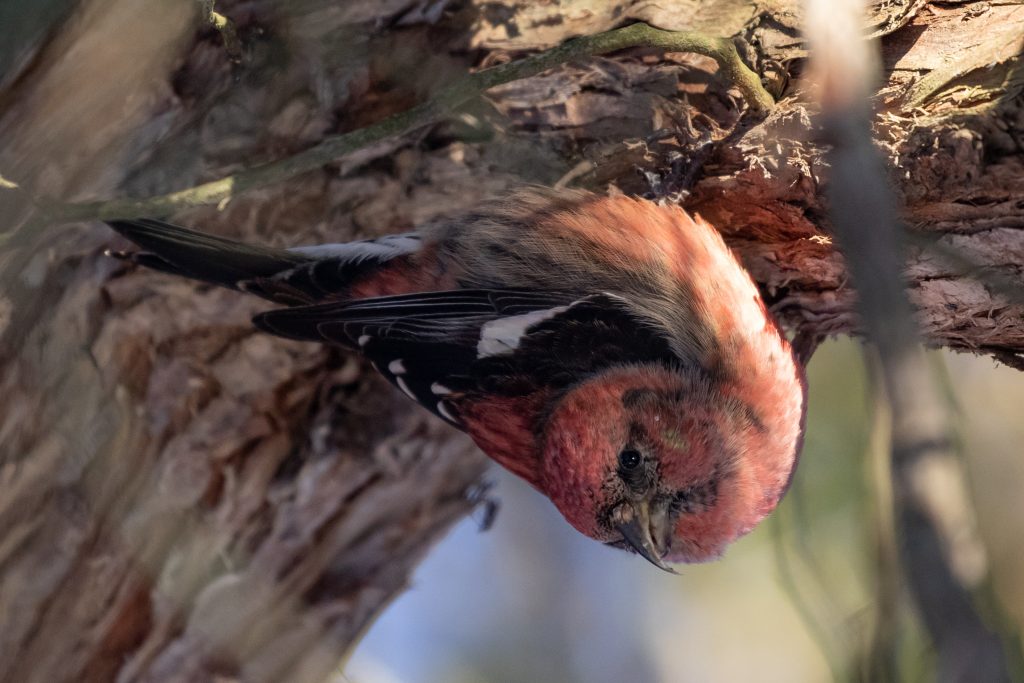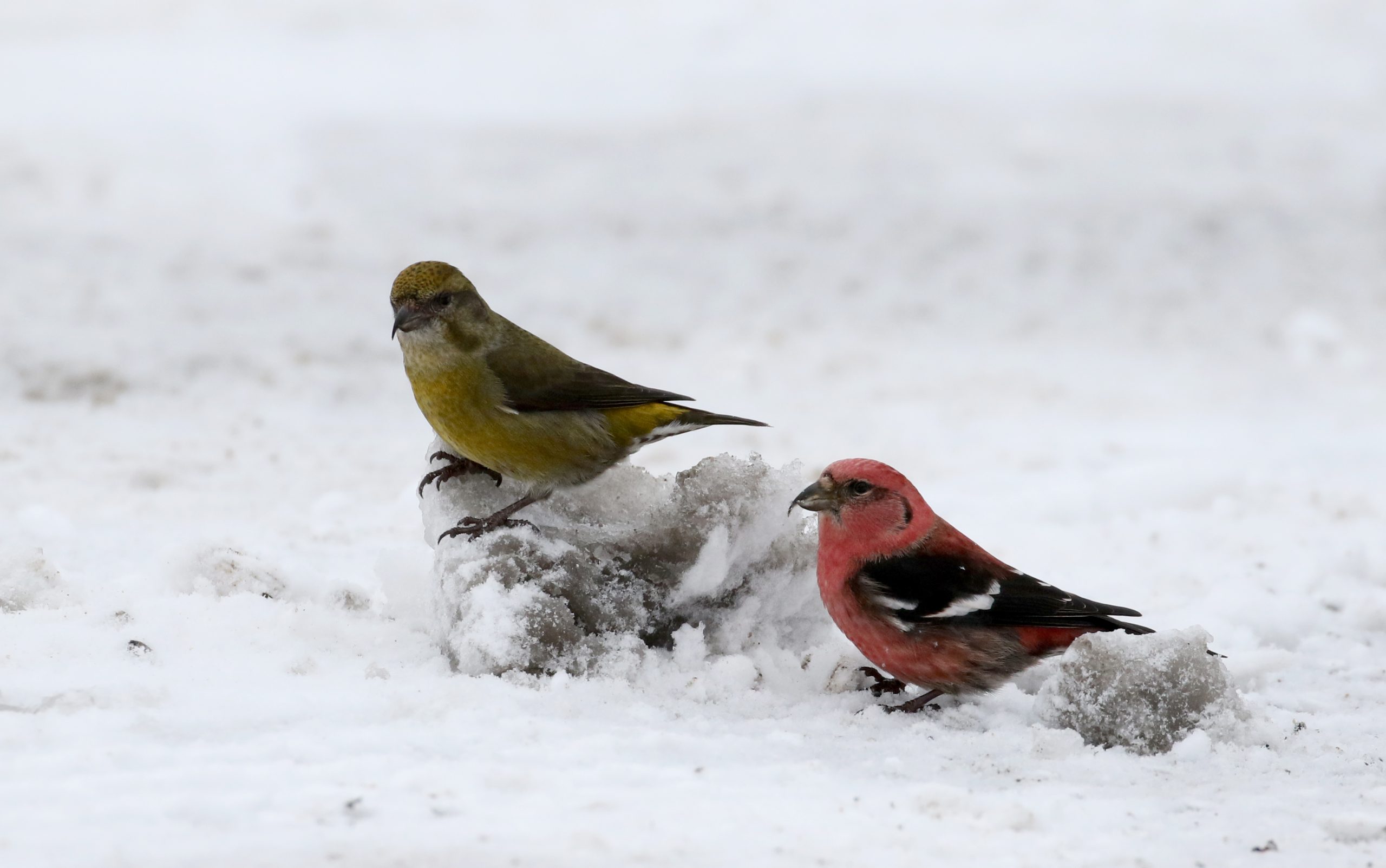Authors Matthew A. Young and Tyler Hoar:
In the first of this three part series on the “Winter Finch Update”, we covered the Pine Grosbeaks and the redpolls in “The Return Begins”. Below we get into the nomads, the crossbills. Next up soon will be “The Budworm Kids”.
Crossbills moved this year, especially Type 10 in the east and Type 2 in the west. Why the need to move, and when does the return flight start? To know that answer one needs a basic understanding of when certain conifers drop their seeds. To a crossbill, it’s all about what is on the menu in any given moment in time through the cone cycle year, which we think of as running from July 1 to June 30. July 1 roughly coincides with when new cone crops have developed and ripened in North America.
Given they are conifer seed specialists, crossbills are more nomadic than other finches, and are always searching for the next rich patch of conifers with seeds to exploit. Based on whether a conifer is a soft-coned one like hemlock, larches, or spruce, or a hard pine like lodgepole, ponderosa, pitch, jack, red, Virginia or loblolly, different foods being available on the menu is key, and this changes depending on location and time of the year.
Soft coned conifer crops form in May to early July, and the seed becomes readily available to crossbills right away since the cones are pliable. Crossbills can even utilize green cones on these soft-coned conifers, especially spruce species like white and Engelmann spruce.. For semi-soft conifers like white and limber pines or Douglas fir, the seeds become accessible later summer into fall; these trees hold their seeds longer through the cone cycle year than the hemlocks, spruces , larches etc. As you go through the cone cycle year there’s less and less on that menu for a crossbill to utilize for reproduction and survival. In a year like this, crossbills in the east are mostly just trying to survive to see another cone crop to utilize for breeding (again this applies to types like type 2 in west and 10 in east that were forced to move this year).
There are however peak times of the year where crossbills typical move more than other times of the year. In typical years, the main peaks of movement are in fall Oct-December when soft and semi-soft conifers drop most of their seeds; they’ll move again in February-March when less and less is on the menu and only the hard conifers hold their seeds. In May-June they are on the move again, but this time in search for newly developing crops to utilize for the July-September (White-winged Crossbills can breed into October) nesting cycle.

In years like this one, when only one conifer species in the northeast produced a viable cone crop (e.g. eastern white pine), the birds were on the move earlier than normal, and many of the birds that bred in winter and spring 2020 in the Maritimes and Northeast moved into southern parts of New England and the Northeast in July-August to feed on this white pine crop. Nesting was pretty limited during this past summer’s breeding cycle (many birds were packed into a relatively small area). During this late summer period, parts of New York, Massachusetts, and southern New Hampshire saw numbers of Type 10 Red Crossbills. As this white pine crop was depleted, Type 10s moved further south to Connecticut, New Jersey, Pennsylvania and points south, with some states reporting their first state records of this call type: North Carolina, Alabama, and Georgia. They also moved westward into the Great Lakes region.
White-winged Crossbills moved in record numbers at Hawk Ridge in Minnesota in October, and a steady stream of smaller numbers also moved out of the eastern boreal into the Northeast too. Outlier birds have been seen as far south in the east as Missouri, North Carolina, Virginia, and Kentucky. White-winged also moved in numbers in British Columbia, and some moved into the southern Rockies as well.

Crossbills likely won’t return to their core breeding areas until May-June when new cone crops are forming. For now, some Red Crossbills and White-winged Crossbills in east will continue to be moving around in their irruption zones. Keep an eye on ornamental conifers in yards and developed areas, because this is the type of year in the east that you could spot them away from their usual forested haunts. And stay tuned for the 3rd part of this series, “The Budworm Kids”! It’ll be out soon.
Cover Photo Credit Jay McGowan
FiRN is a nonprofit, and has been granted 501c3 status. FiRN is committed to researching and protecting these birds and other threatened finch species like the Evening Grosbeak and Rosy-finches, and if you have been enjoying all the blogs and identifying of Red Crossbill call types, redpoll subspecies and green morph Pine Siskins FiRN has helped with, please think about supporting our efforts and making a small donation at the donate link below. We plan to support student research projects and more.
Here’s again the 1st part in this series on Pine Grosbeaks and the redpolls, The Return Begins:
For more on crossbills, please read below:

